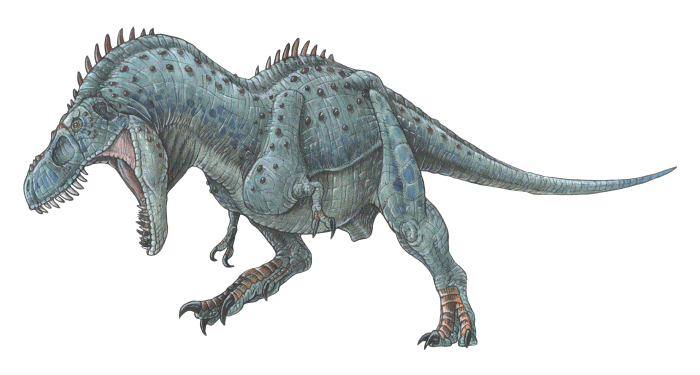|
|
|
Tarbosaurus bataar (E.A. Maleev, 1955) |
 |
|
Name Means: |
"Alarming hero reptile" |
Length: |
40 feet (13 m) |
|
Pronounced: |
TAR-bow-SAWR-us |
Weight: |
6 tons (6,000 kilos) |
|
When it lived: |
Late Cretaceous - 67 MYA |
|
|
|
Where found: |
Mongolia |
|
|
|
|
Introduction |
Tarbosaurus was a carnivorous dinosaur from the
Gobi Desert of southern Mongolia. Like its close North American
relative, Tyrannosaurus, it was one of the last
surviving dinosaurs. Although the skull of Tarbosaurus
was large, it was not very heavy. This was because it was
comparatively thin, and contained large air pockets. The vertebrae and
ribs were hollow, as were the bones of the upper arms. Most
saurischian dinosaurs had light, hollow bones, which allowed them to
grow to large sizes, like Mamenchisaurus, or to be
fast and agile, like Tarbosaurus.
Tarbosaurus is more ancient than the T-rex, it
suggests the genus could initially have appeared in Asia and then
entered North America (through the land bridge connecting these
continents in the Cretaceous). Tarbosaurus was a carnivore, eating
anything it came across. Because of its bulkiness, it was probably a
scavenger. But there is still debate, whether tyrannosaurids were
active predators or scavengers. These dinosaurs were probably herding
animals they could hunt for large herbivorous dinosaurs (Saurolophus etc). Tarbosaurus had sturdy and quite long
legs and its fore limbs were reduced as typical of all carnosaurs.
Function of their forelimbs is still not clear. Like other
tyrannosaurs, it had a huge head with large cutting serrated teeth.
Its brain was unbelievably tiny in comparison with its huge body. |
|
Discovery |
|
The Sino-Swedish Paleontological Expeditions of 1927-31 to the Gobi
in China turned up some nondescript tyrannosaurid material, but it was
not until after World War II that the Gobi yielded its first bonanza
of tyrannosaurid specimens, including excellent, nearly complete
skulls and skeletons of what seemed to be several new species. In
1946, the Paleontological Institute of the Soviet Academy of Sciences
(Akademia Nauk) negotiated with the Mongolian People's Republic to
send expeditions to the Gobi to search for fossils. The first
expedition, during the summer of 1946, was mainly for reconnaissance,
to prospect for sites where interesting fossils might be uncovered.
These were found all over the southeastern Gobi, but especially in the
Nemegt Basin It was on this reconnaissance expedition that the huge
partial skull and vertebrae of a gigantic tyrannosaurid were
unearthed. It was a spectacular discovery: the first good
tyrannosaurid specimen to be found in Asia. The follow-up
expedition did not occur in 1948. On May 9, field technician J. Eaglon came across a ten-meter-long skeleton, nearly complete, in red
sandstone of what are now known as the Upper Nemegt Beds. The
expedition promptly called it "Eaglon's skeleton." It was the first of
seven more or less complete tyrannosaurid skeletons of various sizes
brought back to Moscow by the expeditions of 1948 and 1949. In
addition, partial skulls, fragmentary skeletons, isolated bones, and
scattered teeth of tyrannosaurids almost too numerous to count were
exhumed. Considering the rarity of tyrannosaurids in North America, this was a real windfall. |
|
Classification |
After the third and final Academy of Sciences expedition in 1949,
the work of describing the Gobi dinosaurs fell to Maleev. In two brief
papers in 1955, in consecutive issues of the Proceedings ["Doklady"]
of the USSR Academy of Sciences, he established one new genus and four
new species for the tyrannosaurids. In his initial paper, he described
the 1946 specimen (PIN 551-1), with a skull (were it complete)
slightly larger than that of AMNH 5027, as the holotype of the new
species Tyrannosaurus bataar (the trivial name derives from the
Mongolian for "hero" or "warrior"; Figure 26). The other three taxa
were described in his second paper: Tarbosaurus efremovi ("Efremov's
frightening lizard") for a nearly complete skeleton about 10-12 meters
long (PIN 551-2; Figure 27); Gorgosaurus lancinator ("shredder" or
"one who tears to pieces") for a skull and associated fragmentary
postcranial remains of an animal about 9 meters long (PIN 553-1;
Figure 28); and Gorgosaurus novojilovi (honoring geologist Novozhilov)
for an incomplete skull and associated fairly complete skeleton about
6 meters long. In 1955, Maleev named this species Tarbosaurus
bataar. It was later reclassified as a tyrannosaur.
Recent studies have determined that T. bataar is differentiated from T. rex by smaller
forelimbs (Horner and Lessem, 1993), the angular terminates in front
of the surangular fenestra, the surangular fenesta is smaller, and the
maxilla ends behind the lachrimal (Carenter, 1992). There have also
been no specimens of T. bataar reported outside of Asia. These
discoveries resulted in this animal being returned to full generic
status. Tyrannosaur bataar is now Tarbosaurus bataar. |
|
Species
|
|
The above studies
have also shown that there is a strong possibility that
Shanshanosaurus is a juvenile Tarbosaurus, sinking that
genus. There is a possibility that T. bataar can be split further
into T. bataar and T. efremovi. As of today, Only one species of Tarbosaurus, T. bataar, has been
officially established. |
|
|
|
|
|
|
|
|
Edugraphics.Net | Feenixx Publishing |
|
|
|
|
